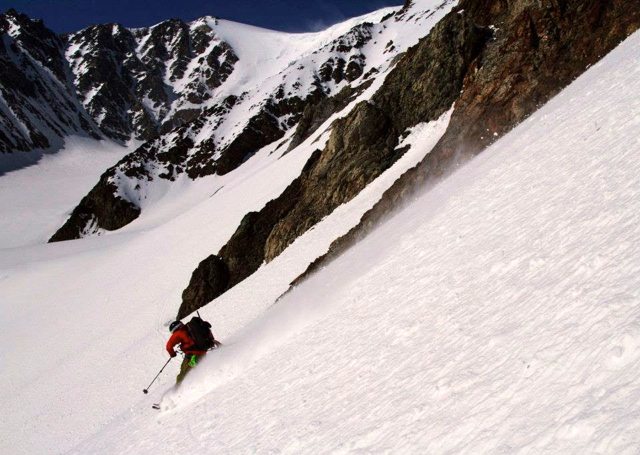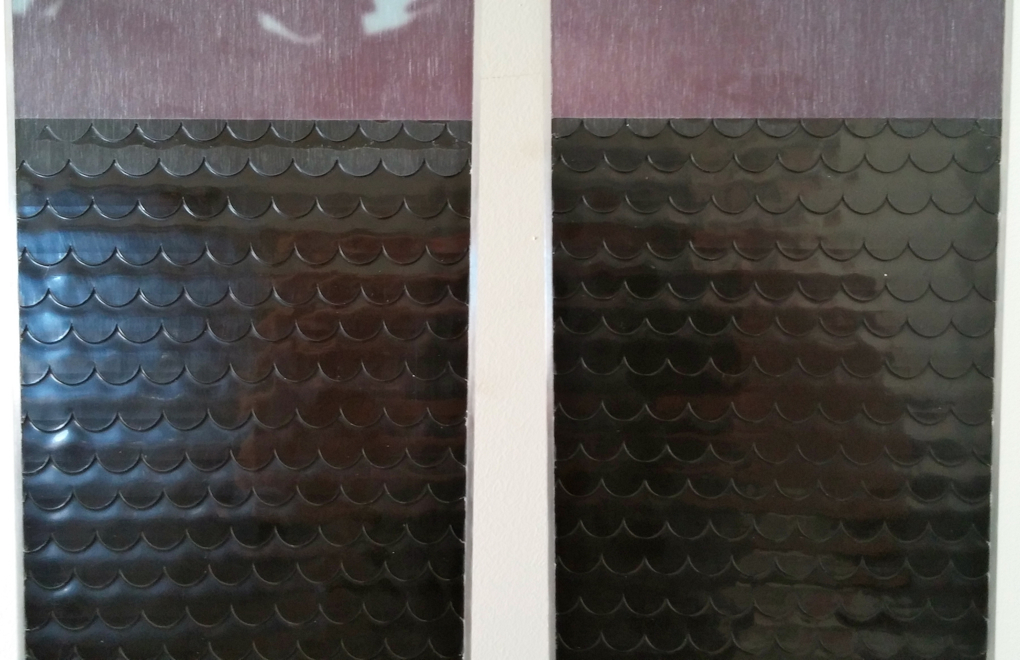
Ski: 2015-2016 Voile Charger BC, 191cm
Dimensions (mm): 140-114-128
Sidecut Radius: 25.4 meters
Actual Tip-to-Tail Length (straight tape pull): 189.5cm
Blister’s Measured Weight per Ski: 1782 and 1830 grams
Boots / Bindings (DIN setting): Scarpa Maestrale, Release value of 10 on Plum Guides, 10 on TLT Radicals
Mount Location: Boot Center
MSRP: $595
Test Locations: Taos backcountry; Santa Fe Backcountry and inbounds; Jackson Hole Backcountry
Days Skied: 8 on the Voile Charger BC; 50+ on the Voile Charger
[Editor’s Note: Our review was conducted on the 13/14 Charger BC, which was not changed for 14/15 or 15/16.]
Background
A couple years ago, I was spending some serious time hunting through ski reviews and websites, looking for a way to cut weight on my backcountry setup without ending up on a pair of absurd little rando boards.
At the time, I was focusing almost exclusively on DPS skis, as both their weights and their designs were extremely attractive. But I kept hesitating on the purchase on account of the price. And just as I was about to sell my grandmother’s earrings and pull the trigger, I ran into a buddy who had picked up a pair of Voile Drifters and had great things to say about them.
Once I started looking into Voile, I came across the Charger. The ski was lightweight, inexpensive, and fit my profile for a 110-115mm-waisted ski that looked like it would be pretty versatile.
Turns out, they were.
More recently, Voile came out with “BC” versions of several of their most popular ski models. This meant they took the existing skis, gave them new topsheets, and put fish scales on slightly less than half the base.
First thought: WTF? My dad skis on 83mm straight touring skis with fish scales, and, while he excels at advanced calculus and boolean algebra, he does not rip steep couloirs in the alpine.
Second thought: Hang on, maybe this is brilliant.
I’ve skied the Voile Chargers (not the BC model) for a couple of years now, everywhere from New Mexico to AK.

I’ve loved them as a light, very capable, touring ski. Some of the tours in places like Teton National Park and our local backcountry involve fairly long, flat approaches or egresses, and I’ve been really curious as to how the fish scales would perform on those long, low-angle tours, and whether or not I’d lose any appreciable amount of downhill performance.

And since the fish scales are the piece of this puzzle about which I am the most excited, that’s where I’ll start. Voile makes several claims about the Charger BC. Namely, that:
1) There’s no compromise (by adding the waxless scale pattern).
2) You can leave your skins in the pack in rolling terrain or for one more quick lap.
3) [Still has the] Great benefits of the traditional Charger line.
4) Easy to ski in conditions ranging from the deepest powder to the most difficult wind slab.
5) Built with Voile’s signature lightweight construction.
In order, here we go:
Claim #1: No compromise? Mostly true. The compromise is that you lose approximately 10% of your glide while running on flat bases.
Real world correlation? Don’t take these inbounds. They’re full-on annoying. When you drop into the cat-track run outs, you will notice yourself going significantly slower than all of your friends, and you will be frustrated.
However, when you’re in terrain that asks you to make turns, (i.e. most of our BC lines) you won’t even notice the scales are there. I couldn’t feel them at all in soft snow, and on hardpack, when I was really curious if I’d notice the scales in a rolling transition from edge to edge, (not jump turns) I could feel them as I flattened the bases if I was really paying attention, but it never bothered me.
Claim #2: Leave your skins in the pack. This is half-true. Are you going for another quick lap? Did you set your skin-track while using skins? Cool. You’ll need them again. Fish scales are not a replacement for skins, which is why skins became popular in the first place.
In the most optimal terrain and conditions for fish scales I’ve had these out in, (third person on a fresh skin track in a storm that came in around 12%) I could climb as steep as about 20 degrees (+/- 1 or 2) before losing traction. For reference, this is about when I really feel like I need a heel riser (though I do try to push it a bit). If you’re breaking trail, you won’t be able to climb quite as steeply, since the front of the ski will sit higher in the fresh snow than the tail, creating a steeper track angle.
Other half of the truth: Are you in rolling terrain? Great, you’re stoked. On a recent tour, the exit included about 3/4 of a mile of mostly flat terrain, followed by two to three miles of low-angle, rolling downhill, followed by two to three miles of low-angle uphill. This is how it broke down:
In the flats, I broke trail for my buddy until he gave up and put on skins, while I waited. He happened to give up about 100 yards from where the downhill started. Since we were both out there for the first time and didn’t have a great feel for the terrain, he left his skins on for the downhill while I rallied ahead and waited…and waited…and waited.
Once we got to the uphill, we were right together, for a while. As I mentioned earlier, fish scales are not a replacement for skins, and there are a couple of places where they suck: namely, on used up and refrozen skin tracks. The waxless pattern provides absolutely no lateral stability, which means that if you’re traveling on a worn-out skin track, or an off-camber x-country ski / snowshoe / hiking track, you’re going to find yourself frustrated by the amount of sliding back and forth. I made it about a mile uphill before the frustration from the haggard and frozen track took over, and I threw my skins back on.
In sum, for most rolling terrain, the waxless pattern is going to win. If I hadn’t waited, I bet I would’ve been 20% faster on the egress than my amigo with a standard skin set-up.
On that same tour, if he had really optimized skin use, he would have put them on at the beginning of the flat meadow, taken them off for the downhill, and put them back on for the climb. Since the downhill had a couple of short, rolling ups, he probably would have had to sidestep for a long while where I could just climb straight through.
Claim #3: Great benefits of the traditional Charger line. The truth-o-meter reads 100% on this one. It feels like the tip on the Charger BC is a tiny bit softer, leading to slightly less of a no-holds-barred ripper. But, to be fair, this ski was never designed as a no-holds-barred-destroyer-of-everything-in-its-path (more on performance in a bit). It’s a soft, consistent-snow backcountry ski. If you want a ski with a similar shape that is much better in bad snow, look at the Moment Governor (which weighs ~400 grams more per ski), and I’ll see you at the bar, three beers in, after you’ve finished carrying them to the top of the mountain just so you could rattle down through refrozen avy debris at high speeds.
Flex Pattern and Layup
The Charger BC is very similar to the Charger. Dimensions are identical, and flex patterns are close: the regular Charger handflexes stiffer all around, and it’s tails are very stiff. The Charger BC has medium tips, soft shovels, and medium/stiff tails.
Voile hasn’t changed any part of the layup of the boards. They’ve just added those fish scales, and moved to a more durable top sheet. Again, the Charger BCs hand flex a little softer than the Chargers, but there’s really not a noticeable difference in performance between the Charger and the Charger BC. So, do you want a lightweight ski with little sidecut, a stiff tail, and good tip rocker? Do you want to pay half of what you’d drop for a DPS ski of a similar weight? Here you go.

I was really interested in the Voile V6, but the scales has me at least looking into this ski. I generally like a small radius ski (non BC skis are atomic automatic, line prophet 98), so i don’t think that something with this radius would suit my style of skiing. Has anybody ridden the V6 or V8 from Voile as a comparison – as I am intersted in those for sure. Thanks
I would love to see a comparison I the charger, vector and nunataq.
Personally, I love the vector bc. It’s great to be able to leave the skins in the backpack, and I feel like I can ski the vector almost anywhere, though maybe not as fast as on my downhill skis (blizzard answer, peacemaker and volkl katana). That being said I’m happy skiing anything.
I bought my wife a pair though and she’s not as impressed. She comes from a racing background and doesn’t like the vector at all – seems too soft we think but not sure.
Would love to see your thoughts on charger vs vector. We suspect the nunataq would be her best choice but not sure.
I wonder if she would prefer the charger BC. We know he loves the kiku and would probably like the nunataq but no bc pattern.
I’ve had Volie BC’s (Vectors) with tech bindings since the 13/14 season and I agree with this reviewer, they’re an excellent choice for the backcountry when you have low angle entries and/or exits. Sure beats the hell out of slogging the flats with skins, or taking them off and on to handle rolling terrain.
My Vector’s also don’t like back seat drivers and get deflected pretty easily in chop, crust or crud, too. But in any kind of powder they’re plain awesome.